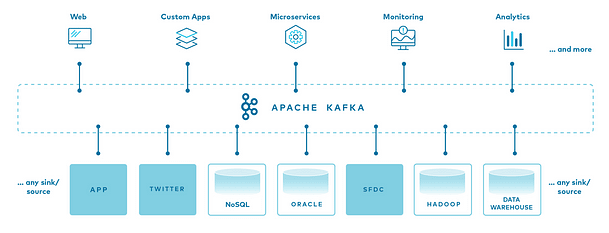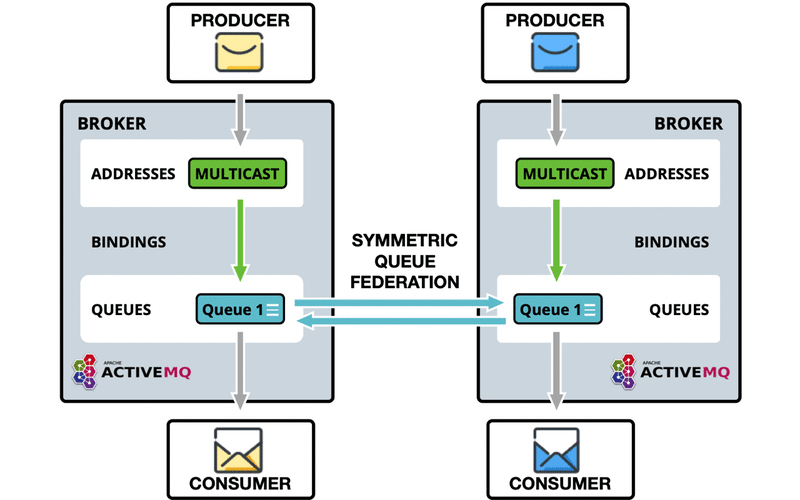Disclosure: This post includes affiliate links; I may receive compensation if you purchase products or services from the different links provided in this article.
image_credit - Design Guru
Hello devs, if you are preparing for System Design interviews then along with popular software design questions like API Gateway vs Load Balancer and Horizontal vs Vertical Scaling, Forward proxy vs reverse proxy, you should also prepare about things like messaging brokers, kafka, rabbitmq, and activemq like what is difference between Kafka, RabbitMQ, and ActiveMQ?, which is also one of the popular questions on Java interviews.
In my last article, I shared about 50 System Design Interview Questions and REST vs GraphQL vs gRPC, and in this article, I am going to share my thoughts on Kafka, RabbitMQ, and ActiveMQ, three popular message brokers used for asynchronous communication.
Messaging systems and Message brokers play a crucial role in modern distributed architectures, where applications and services communicate with each other over a network.
The messaging systems allow decoupling of the sender and receiver, thereby enabling asynchronous communication. RabbitMQ, Apache Kafka, and ActiveMQ are three popular messaging systems used in the industry.
In this article, we will discuss the differences between RabbitMQ, Apache Kafka, and ActiveMQ.
By the way, If you are preparing for System design interviews and want to learn System Design in depth then you can also checkout sites like ByteByteGo, Design Guru, Exponent, Educative and Udemy which have many great System design courses and if you need free system design courses you can also see the below article.
And, if you are in hurry, here is a table from ByteByteGo which compares Kafka with RabbitMQ on different parameters like architecture, structure, working etc
What is Apache Kafka and where does it used?
Apache Kafka is an open-source distributed event streaming platform that was originally developed by LinkedIn. Kafka is written in Scala and Java and is designed to handle large-scale streaming data flows.
Kafka uses a publish/subscribe messaging model and is optimized for high throughput, low latency, and fault-tolerance.
Kafka has a durable messaging model, which means that messages are stored on disk and can be replayed multiple times.
If you want to learn more about Kafka, particularly from System design point of view, you can also join ByteByteGo, a great platform to learn essential system design concepts
What is RabbitMQ and where does it used?
RabbitMQ is an open-source message broker that implements the Advanced Message Queuing Protocol (AMQP) standard.
It is written in Erlang and has a pluggable architecture that allows for easy extensibility.
RabbitMQ supports multiple messaging patterns such as publish/subscribe, request/reply, and point-to-point, and it has a robust set of features such as message acknowledgment, routing, and queuing.
Arslan ahmend has explained about RabbitMQ in his classic Grokking the System design interview course, if you are preparing for tech interview, you can also see that resource for better preparation.
What is ActiveMQ? where does it used?
Apache ActiveMQ is an open-source message broker that implements the Java Message Service (JMS) API. ActiveMQ is written in Java and has a pluggable architecture that allows for easy extensibility.
ActiveMQ supports multiple messaging patterns such as point-to-point, publish/subscribe, and request/reply, and it has a robust set of features such as message acknowledgment, routing, and queuing.
Differences between RabbitMQ, Apache Kafka, and ActiveMQ?
Now that you have fair idea of what is RabbitMQ, ActiveMQ, and Apache Kafka, its time to find out the difference between them from messaging model to performance.Here are key differences between Apache Kafka, RabbitMQ and ActiveMQ:
1. Messaging Model
RabbitMQ and ActiveMQ both support the JMS API, which means that they follow a traditional messaging model where messages are sent to a queue or a topic and consumed by one or more consumers.
On the other hand, Kafka uses a publish/subscribe messaging model, where messages are published to a topic and consumed by one or more subscribers.
The traditional messaging model used by RabbitMQ and ActiveMQ is well-suited for applications that require strict ordering and reliable delivery of messages.
On the other hand, the publish/subscribe messaging model used by Kafka is better suited for streaming data scenarios, where real-time processing of data is required.
Here is a nice diagram which highlight the architecture difference between Kafka and RabbitMQ
2. Scalability
Scalability is an essential requirement for messaging systems, especially when dealing with large volumes of data. RabbitMQ and ActiveMQ are both designed to be scalable, but they have different approaches to achieving scalability.
RabbitMQ uses a clustering approach to achieve scalability, where multiple RabbitMQ brokers are connected to form a cluster. Messages are distributed across the cluster, and consumers can connect to any broker in the cluster to consume messages.
RabbitMQ also supports federation, which allows multiple RabbitMQ clusters to be connected together.
ActiveMQ uses a network of brokers approach to achieve scalability, where multiple ActiveMQ brokers are connected to form a network.
Messages are distributed across the network, and consumers can connect to any broker in the network to consume messages. ActiveMQ also supports master/slave replication, which provides high availability for the message broker.
Kafka, on the other hand, is designed to be highly scalable out of the box. Kafka uses a partitioning approach to achieve scalability, where messages are partitioned across multiple Kafka brokers.
Each partition is replicated across multiple brokers for fault tolerance. This approach allows Kafka to handle large volumes of data while maintaining low latency and high throughput.
3. Performance
Performance is another critical factor to consider when choosing a messaging system. RabbitMQ, Kafka, and ActiveMQ all have different performance characteristics.
RabbitMQ is designed to be a reliable messaging system, which means that it prioritizes message delivery over performance.
RabbitMQ can handle moderate message rates and is suitable for applications that require strict ordering and reliable delivery of messages.
Kafka, on the other hand, is designed for high-performance and can handle large volumes of data with low latency. Kafka achieves this performance by using a distributed architecture and optimizing for sequential I/O.
ActiveMQ is also designed for high-performance and can handle high message rates. ActiveMQ achieves this performance by using an asynchronous architecture and optimizing for message batching.
Here is a chart from confluent which compares performance of Apache Kafka, Pulsar and Rabbit MQ
Benchmarking Apache Kafka, Apache Pulsar, and RabbitMQ: Which is the Fastest?
4. Data Persistence
Data persistence is an important feature of messaging systems, as it allows messages to be stored and retrieved even if the messaging system goes down. RabbitMQ, Kafka, and ActiveMQ all have different approaches to data persistence.
RabbitMQ stores messages on disk by default, which allows messages to be persisted even if the broker goes down.
RabbitMQ also supports different storage backends, including in-memory storage, which provides better performance at the cost of data durability.
Kafka stores messages on disk by default and uses a log-based architecture to achieve high durability and reliability. Kafka retains messages for a configurable period, which allows messages to be replayed if necessary.
ActiveMQ also stores messages on disk by default and supports different storage backends, including JDBC and file-based storage. ActiveMQ can store messages in a database, which provides better data durability at the cost of performance.
Here is a nice diagram from IBM which shows a Kafka architecture:
image --- https://ibm-cloud-architecture.github.io/refarch-eda/technology/kafka-overview/
5. Integration with Other Systems
Integration with other systems is an important factor to consider when choosing a messaging system. RabbitMQ, Kafka, and ActiveMQ all have different integration capabilities.
RabbitMQ integrates well with different programming languages, including Java, Python, Ruby, and .NET. RabbitMQ also has plugins that allow it to integrate with different systems, including databases, web servers, and message brokers.
Kafka integrates well with different data processing systems, including Apache Spark, Apache Storm, and Apache Flink. Kafka also has a connector framework that allows it to integrate with different databases and data sources.
ActiveMQ integrates well with different JMS clients, including Java, .NET, and C++. ActiveMQ also has plugins that allow it to integrate with different systems, including Apache Camel and Apache CXF.
Here is also a nice table to highlight the difference between Kafka, Rabbit MQ, and ActiveMQ
System Design Interviews Resources:
And, here are curated list of best system design books, online courses, and practice websites which you can check to better prepare for System design interviews. Most of these courses also answer questions I have shared here.
DesignGuru's Grokking System Design Course: An interactive learning platform with hands-on exercises and real-world scenarios to strengthen your system design skills.
"System Design Interview" by Alex Xu: This book provides an in-depth exploration of system design concepts, strategies, and interview preparation tips.
"Designing Data-Intensive Applications" by Martin Kleppmann: A comprehensive guide that covers the principles and practices for designing scalable and reliable systems.
LeetCode System Design Tag: LeetCode is a popular platform for technical interview preparation. The System Design tag on LeetCode includes a variety of questions to practice.
"System Design Primer" on GitHub: A curated list of resources, including articles, books, and videos, to help you prepare for system design interviews.
Educative's System Design Course: An interactive learning platform with hands-on exercises and real-world scenarios to strengthen your system design skills.
High Scalability Blog: A blog that features articles and case studies on the architecture of high-traffic websites and scalable systems.
YouTube Channels: Check out channels like "Gaurav Sen" and "Tech Dummies" for insightful videos on system design concepts and interview preparation.
ByteByteGo: A live book and course by Alex Xu for System design interview preparation. It contains all the content of System Design Interview book volume 1 and 2 and will be updated with volume 3 which is coming soon.
Exponent: A specialized site for interview prep especially for FAANG companies like Amazon and Google, They also have a great system design course and many other material which can help you crack FAAN interviews.
image_credit - ByteByteGo
Remember to combine theoretical knowledge with practical application by working on real-world projects and participating in mock interviews.
Conclusion
That's all about the difference between Apache Kafka, RabbitMQ, and ActiveMQ. While RabbitMQ, Apache Kafka, and ActiveMQ are three popular messaging systems that have different features and capabilities.
RabbitMQ and ActiveMQ follow a traditional messaging model, while Kafka uses a publish/subscribe messaging model.
RabbitMQ and ActiveMQ use clustering and network of brokers approaches to achieve scalability, while Kafka uses partitioning. RabbitMQ prioritizes message delivery over performance, while Kafka and ActiveMQ prioritize performance. RabbitMQ, Kafka, and ActiveMQ all have different data persistence and integration capabilities.
When choosing a messaging system, it is essential to consider the specific requirements of the application or system.
RabbitMQ and ActiveMQ are suitable for applications that require strict ordering and reliable delivery of messages, while Kafka is suitable for streaming data scenarios.
RabbitMQ and ActiveMQ are suitable for applications that require moderate to high message rates, while Kafka is suitable for applications that require high message rates.
Similarly, RabbitMQ and ActiveMQ are suitable for applications that require high data durability, while Kafka is suitable for applications that require high performance.

















Top comments (3)
thank u v much
your welcome, thanks for your comment.
there are some inexactitudes and inconsistencies which make me wonder how much I can trust this writing. Kafka has a golang client (and probably others), the ordering is guaranteed at level of partition (not topic), the Pulsar is thrown in while nobody was asking, all in all it reads like another try to make some impression to someone